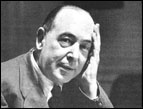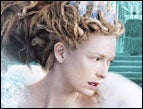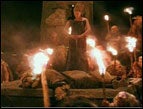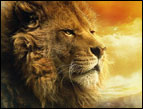

Become a CBN partner and receive The Transforming Word: Verses to Overcome Fear and Experience Peace, our special DVD/CD gift to you.
CBN Partners are making a difference sharing the Gospel of Jesus Christ. Find out how.
CBN.com – As a co-producer of the upcoming film of C.S. Lewis’ classic children’s book The Lion, The Witch and The Wardrobe, Douglas Gresham has had the unique privilege of seeing the world of Narnia brought to life for everyone to experience. We now have a chance to step into that same world with someone who grew up in a home where “all things Narnian” were a part of everyday life.
“For me Narnia was real -- is real,” says Gresham. “Always has been. The fact that I can’t live in it here and now has got nothing to do with it, as far as I’m concerned.
“The whole scene in which we lived -- the wood and the lake at the Kilns were absolutely Narnian in character.
“Narnian landscapes are based very much on Irish, English and Welsh landscapes. Jack used to love going on walking tours and had walked all of these lands.
“We would be walking through the wood, and we might see a little spot and say, ‘Oh that… Wouldn’t a fawn love to live there?’
“In everyday natural conversation in the Kilns, a Narnian character or creature would just pop his way into that conversation as if he was there by right. And he was.”
 “When Lewis wrote The Chronicles of Narnia, he said he didn’t set out to preach. He didn’t set us to tell a Sunday school story,” says Don King, Professor of English at Montreat College in North Carolina. “He said Aslan wasn’t even in the story. Aslan came bounding in on his own.”
“When Lewis wrote The Chronicles of Narnia, he said he didn’t set out to preach. He didn’t set us to tell a Sunday school story,” says Don King, Professor of English at Montreat College in North Carolina. “He said Aslan wasn’t even in the story. Aslan came bounding in on his own.”
Louis Markos, PhD. Professor in the Houston Baptist University says, “Aslan is Christ. Lewis asked himself, What if the second person of the trinity were incarnated in a magical world of talking animals and living trees… what might he be like?”
The Reverend Dr. Malcom Guite is the chaplain of Girton College in Cambridge, England. “From the day I first read it, I’ve been spending my whole life knocking on the backs of cupboards saying, ‘Let me in. I want to find this world.’ Actually the doorways are everywhere. It’s very much a feel of that passing through from the apparently ordinary into the extraordinary and the beautiful behind it,” he says.
 “It’s been a lifelong dream of mine to see a really good movie of The Lion, The Witch and The Wardrobe,” says Gresham. “Well, the Narnia chronicles in general. So to see it suddenly coming to life and exceeding my own expectations, as you can imagine, is a great thrill.
“It’s been a lifelong dream of mine to see a really good movie of The Lion, The Witch and The Wardrobe,” says Gresham. “Well, the Narnia chronicles in general. So to see it suddenly coming to life and exceeding my own expectations, as you can imagine, is a great thrill.
“Any play or any production of, for example, The Lion, The Witch and The Wardrobe, as far as I’m concerned, has to have the essential story religiously adhered to. This movie does. It’s very faithful.”
“Aslan is the Turkish word for lion,” author Eric Metaxas. “So that’s where he got that from. By telling the story on a completely different plain, it helps us to look at the story fresh, as though we were all in a culture that had never heard the Christian story before.”
Markos says, “I once went to a church where on Easter instead of reading the crucifixion, they actually read the killing of Aslan to help us. Lewis wanted us to learn to feel a certain way about Christ again.”
 “My wife said that after reading the one [where] Aslan comes back to life and he’s playing with Lucy and Susan, for the first time in her life she really understood emotionally the love of God,” says King.
“My wife said that after reading the one [where] Aslan comes back to life and he’s playing with Lucy and Susan, for the first time in her life she really understood emotionally the love of God,” says King.
Gresham says, “A lot of the ethos of Narnia comes from 19th century thinking -- things like honor, chivalry, commitment, and duty.”
“Jesus didn’t simply come up with philosophical ideas,” says Metaxas. “He’s not merely a moral teacher. He’s a heroic figure, a mythic figure. He’s the Messiah of the world; He’s the Savior of the world. When you start talking in that kind of language, it’s a deeper language.”
“Lewis explores goodness in Aslan, but he also explores evil in the White Witch,” says Markos. “She is beautiful but she is cold. She is a devourer. She has made Narnia always winter but never Christmas.”
Author Vishal Mangalwadi says, “The witch and the lion are opposites. The witch has enslaved and the lion, who represents the Lion of Judah, which is Jesus Christ, He liberates.”
 Guite concurs, “What Lewis wants us to do is to meet an inner Aslan. I think Lewis really believed that Christ, the light who lightens everyone who comes into the world, clothes our imagination. The Aslan that you see for yourself; the way you imagine that kind of golden glory; the way you as a child and as an adult get to the moment where you stand and look in the lion’s face and he breathes on you… that has to be an inner event."
Guite concurs, “What Lewis wants us to do is to meet an inner Aslan. I think Lewis really believed that Christ, the light who lightens everyone who comes into the world, clothes our imagination. The Aslan that you see for yourself; the way you imagine that kind of golden glory; the way you as a child and as an adult get to the moment where you stand and look in the lion’s face and he breathes on you… that has to be an inner event."
Enter to win the Chronicles of Narnia Prize Package Giveaway
A caring friend will be there to pray with you in your time of need.